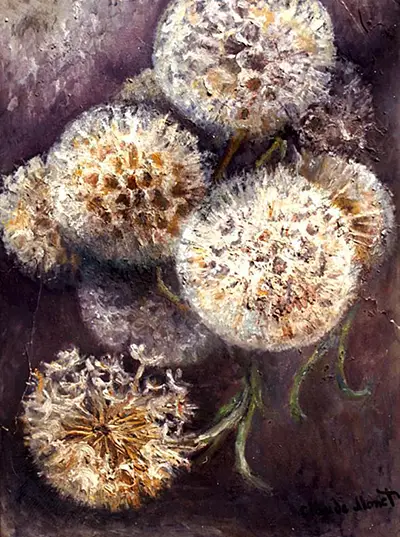Monet, like many of his contemporaries, delighted in gardens and acquired a large garden later in his career investing a lot of money and time in creating an area of great beauty after the impecunious struggles of his younger years.
His garden obviously became a source of great inspiration with an abundance of natural subject matter with rich and varied hues, shapes and textures.
Claude Monet said that, "my only merit lies in having painted directly in front of nature, seeking to render my impressions of the most fleeting effects." This phrase epitmosises his attempt to capture the transient nature of life and the natural world, and nothing is more fragile and temporary than the spores of a dandelion flower that last for such a brief time.
The painting perfectly captures the ethereal nature of the flowers that seem to protrude out of the canvas as if they will blow away if we breathe on them or if a draft of air brushes past.
The flowers are shown in such close up detail that there is almost a botanical quality, and the touches of the remaining yellow of the dandelion petals can just be detected under the white fluff of the spores. Most of them are perfect and whole for this moment, but the lower flower looks as though some of the spores have started to drift away, and we know the others will not last long and it is only a matter of time before they all disintegrate.
The painting illustrates the beauty in simplicity that is at the heart of many of Monet’s works whether it be a simple shoreline setting or the humble dandelion that is considered no more than a weed by many. Despite his garden at Giverny being developed with family and gardeners as a creative project with pansies, impatiens, peonies and lavender, it was the simple dandelion that Monet chose to represent in this simple but effective painting.
Compared to his early life the house and garden at Giverny were indeed splendid beyond measure and of course provided a haven of beauty and escapism for the artist and his family and friends. However Monet loved to paint gardens long before he started to develop his own garden at Giverny and his early paintings show people in numerous outdoor settings and other peers of his time such as Matisse, Bonard, Renoir and Pissarro all had a different take on the garden theme.
It is clear to see that Monet regarded all of nature beautiful and inspirational from sensual roses to simple dandelions and his love of flowers comes through vividly in this evocative painting.


